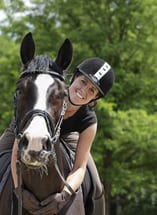Proper Equine Feeding Practices
 Horses in a natural setting spend about 60 percent of their time grazing. When domesticated horses are pastured, they will do the same, spending no more than 2 to 3 hours at a stretch in non-eating behaviors. Being herd animals, horses in nature eat with a group of their comrades. While domesticated horses are usually happy doing the same, there are a few drawbacks to group feeding. Since overfeeding is a real danger with horses and since each animal has individual nutritional requirements depending on its age, size, gender, and reproductive state, horses fed in groups are more likely to be overfed than horses fed separately.
Horses in a natural setting spend about 60 percent of their time grazing. When domesticated horses are pastured, they will do the same, spending no more than 2 to 3 hours at a stretch in non-eating behaviors. Being herd animals, horses in nature eat with a group of their comrades. While domesticated horses are usually happy doing the same, there are a few drawbacks to group feeding. Since overfeeding is a real danger with horses and since each animal has individual nutritional requirements depending on its age, size, gender, and reproductive state, horses fed in groups are more likely to be overfed than horses fed separately.
Dietary Requirements
Most of a horse's diet should consist of roughage. For many trail horses, grain is unnecessary as long as nourishing hay and pasture are available. Even when grain supplements their diet, the bulk of a horse's caloric intake should come from roughage. About 2 percent of the individual horse's body weight should be consumed in roughage daily. For horses kept in stalls for long periods that don't get to graze very much, good quality hay should be constantly available.
For pastured horses, when grass is lush, grain feeding can be minimal. During the winter or during a period of drought, more supplemental grain must be offered. Grain, when provided to horses, should be fed in many smaller meals rather than in one large one. This is the healthiest and most natural way for horses to digest their food.
Individual nutritional needs vary from horse to horse depending on size and energy expended. When a horse's activity level declines, so should its food intake. It is important to measure horse feed accurately, using the scale at the local feed store or one in the stable. A good frame of reference is that a 1,000 pound horse that relies on hay for all its forage, should usually consume 15 to 20 pounds of hay per day. Sometimes horses are provided with nutritional supplements, such as vitamins and minerals, particularly if they are used for racing or other competition.
Feeding Times
 Feeding a horse at the same time each day is generally a good idea. For some more sensitive horses, abrupt changes in feeding schedule may cause colic or other medical problems, so it is best to make changes in diet or feeding time very gradually.
Feeding a horse at the same time each day is generally a good idea. For some more sensitive horses, abrupt changes in feeding schedule may cause colic or other medical problems, so it is best to make changes in diet or feeding time very gradually.
Horses should not eat immediately before or after exercise. The horse should be allowed to digest completely before vigorous exercise so that the circulatory and pulmonary systems are able to work at full capacity. Depending on the size of the meal, 1 to 3 hours should elapse between eating and exercise. Similarly, after exercise the animal should be given the chance to cool down completely before being fed. Whether the appropriate period of time has passed can be assessed by checking that the horse's body is no longer sweaty and its breathing rate is back to normal.
Dangers of Improper Feeding
Not only can improper equine feeding lead to digestive or other medical issues, it can also result in abnormal, possibly risky, behavior. A horse that is fed too little roughage, for example, may engage in wood chewing.
Improper equine feeding can also result in:
- Horse colic
- Choke
- Laminitis (founder)
- Heaves (recurrent airway obstruction)
- Allergic bronchitis
- Electrolyte imbalance ("tying up")
Horses should never be fed foods high in sugar or contaminated by mold. For this reason, sugar cubes are not an acceptable treat for horses and any materials possibly contaminated by mold, such as grass clippings, compost, or fermented hay, should be kept away from horses. Excessive grain can also be dangerous to horse health.
